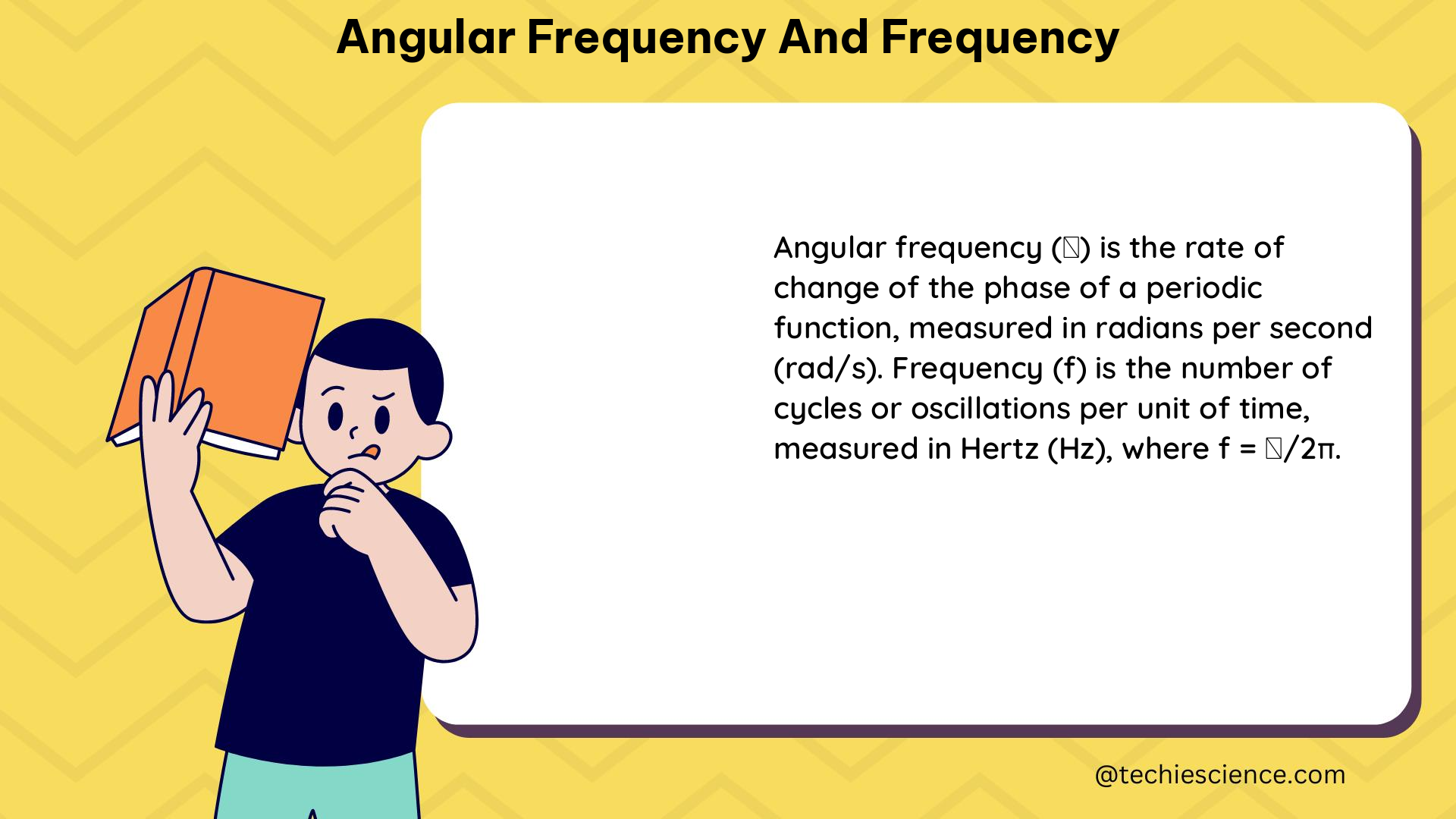Angular frequency and frequency are fundamental concepts in physics that describe the periodic motion of objects. While they are related, they represent distinct quantities that are essential for understanding various phenomena in classical mechanics, electromagnetism, and quantum mechanics.
Understanding Angular Frequency
Angular frequency, denoted by the Greek letter omega (ω), is a measure of the angular displacement of an object per unit time. It represents the rate at which an object completes a full cycle of rotation or oscillation. Angular frequency is measured in radians per second (rad/s) and is calculated using the formula:
ω = 2πf
where f is the frequency of the periodic motion.
The angular frequency of a rotating object can be calculated using the formula:
ω = dθ/dt
where θ is the angular displacement and t is the time.
Examples of Angular Frequency
- Circular Motion: Consider a particle moving in a circular path with a constant speed
vand radiusr. The angular frequency of the particle is given by:
ω = v/r
- Simple Harmonic Motion: In a simple harmonic oscillator, such as a mass-spring system or a pendulum, the angular frequency is given by:
ω = √(k/m)
where k is the spring constant or the restoring force constant, and m is the mass of the oscillating object.
- Electromagnetic Waves: In the context of electromagnetic waves, the angular frequency is related to the frequency
fand the wavelengthλby the equation:
ω = 2πf = 2πc/λ
where c is the speed of light.
Understanding Frequency

Frequency, denoted by the letter f, is a measure of the number of complete oscillations or rotations of a periodic motion in a given period of time. Frequency is measured in hertz (Hz), which represents the number of cycles per second.
The frequency of a periodic motion can be calculated using the formula:
f = 1/T
where T is the period of the motion, which is the time it takes to complete one full cycle.
Examples of Frequency
- Pendulum Clock: The frequency of a pendulum clock is determined by the length of the pendulum and the acceleration due to gravity. The period of a simple pendulum is given by the formula:
T = 2π√(L/g)
where L is the length of the pendulum and g is the acceleration due to gravity. The frequency can then be calculated as f = 1/T.
-
Alternating Current (AC): In an AC electrical circuit, the frequency represents the number of complete cycles of the voltage or current per second. For example, in the United States, the standard AC frequency is 60 Hz, meaning the voltage and current oscillate 60 times per second.
-
Radio Waves: Radio waves are a type of electromagnetic radiation, and their frequency is an important characteristic. Radio stations are assigned specific frequency bands, such as AM (amplitude modulation) and FM (frequency modulation), which operate at different frequency ranges.
Relationship between Angular Frequency and Frequency
As mentioned earlier, the relationship between angular frequency and frequency is given by the formula:
ω = 2πf
This formula allows you to convert between angular frequency and frequency, and vice versa. For example, if you know the frequency of a periodic motion, you can calculate the corresponding angular frequency by multiplying the frequency by 2π.
Numerical Examples
- Simple Pendulum:
- Suppose a simple pendulum has a length
L = 1 mand is located on Earth, where the acceleration due to gravityg = 9.8 m/s². - The period of the pendulum can be calculated using the formula
T = 2π√(L/g), which givesT ≈ 2.01 s. - The frequency of the pendulum can then be calculated as
f = 1/T ≈ 0.497 Hz. -
Using the formula
ω = 2πf, the angular frequency of the pendulum isω ≈ 3.14 rad/s. -
Electromagnetic Waves:
- Consider a radio wave with a frequency of
f = 100 MHz(100 million hertz). - To calculate the angular frequency, we use the formula
ω = 2πf, which givesω ≈ 6.28 × 10^8 rad/s. -
The wavelength of the radio wave can be calculated using the formula
λ = c/f, wherecis the speed of light. Assumingc = 3 × 10^8 m/s, the wavelength isλ ≈ 3 m. -
Simple Harmonic Motion:
- Suppose a mass-spring system has a spring constant
k = 50 N/mand a massm = 2 kg. - The angular frequency of the system can be calculated using the formula
ω = √(k/m), which givesω ≈ 5 rad/s. - The corresponding frequency can be calculated as
f = ω/(2π) ≈ 0.796 Hz.
These examples demonstrate the practical applications of angular frequency and frequency in various areas of physics, such as classical mechanics, electromagnetism, and quantum mechanics.
Conclusion
Angular frequency and frequency are fundamental concepts in physics that describe the periodic motion of objects. Angular frequency measures the angular displacement per unit time, while frequency measures the number of complete oscillations or rotations in a given period of time. The relationship between these two quantities is given by the formula ω = 2πf, which allows for the conversion between them.
Understanding the nuances of angular frequency and frequency is crucial for students and researchers in various fields of science, as these concepts are widely used in the analysis and description of a wide range of physical phenomena.
References:
- StudySmarter. (n.d.). Angular Frequency & Period: Relationship and Formula. Retrieved from https://www.studysmarter.co.uk/explanations/physics/classical-mechanics/angular-frequency-and-period/
- Study.com. (2021, October 11). How to Calculate Angular Frequency Given Standard Frequency. Retrieved from https://study.com/skill/learn/how-to-calculate-angular-frequency-given-standard-frequency-explanation.html
- MRI Questions. (n.d.). Angular Frequency (ω) – Questions and Answers in MRI. Retrieved from https://www.mriquestions.com/angular-frequency-omega.html
- HyperPhysics. (n.d.). Angular Frequency. Retrieved from http://hyperphysics.phy-astr.gsu.edu/hbase/rotq.html
- Khan Academy. (n.d.). Frequency and period. Retrieved from https://www.khanacademy.org/science/physics/oscillatory-motion-and-waves/introduction-to-waves/a/frequency-and-period

Hello, I’m Manish Naik completed my MSc Physics with Solid-State Electronics as a specialization. I have three years of experience in Article Writing on Physics subject. Writing, which aimed to provide accurate information to all readers, from beginners and experts.
In my leisure time, I love to spend my time in nature or visiting historical places.
Looking forward to connecting you through LinkedIn –